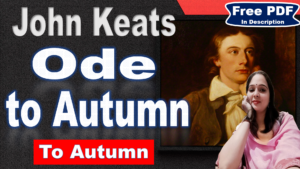A Poet’s Epitaph Analysis
Stanza 1
Art thou a Statist in the van
Of public conflicts trained and bred?
—First learn to love one living man;
‘Then’ may’st thou think upon the dead.
Explanation: In these opening lines, Wordsworth addresses individuals who are heavily involved in public and political affairs—statists, or those who manage or influence government and societal conflicts. He suggests that before they can truly understand and honor the significance of those who have passed away, they must first learn to appreciate and love a single living person.
The idea is that true understanding and respect for the dead come from a deep and genuine appreciation of life and the people around us. For a person engaged in the complexities of public life, this means prioritizing personal connections and demonstrating compassion in their immediate relationships. Only by cultivating such personal and emotional depth can one attain a meaningful perspective on the value of life and death.
Poetic Device
Rhetorical Question: The stanza opens with a rhetorical question, “Art thou a Statist in the van / Of public conflicts trained and bred?” This device engages the reader and sets up a contrast between different types of people.
Contrast: Wordsworth contrasts the life of a statist, involved in public conflicts, with the idea of genuinely loving and understanding a single living person. This sets up a critique of those who are consumed by public affairs without personal depth.
Stanza 2
A Lawyer art thou?—draw not nigh!
Go, carry to some fitter place
The keenness of that practised eye,
The hardness of that sallow face.
Explanation: Wordsworth is telling lawyers not to come near the grave. He believes that their sharp, critical thinking and their serious, sometimes hardened attitudes don’t match well with the peacefulness of a graveyard. The poet thinks that the qualities of a lawyer, such as their intense focus and stern demeanor, are not appropriate in this setting and would be better suited elsewhere. This reflects the idea that people with different professions and attitudes approach the concept of death in varied ways, and not all are fitting for the quiet and humble nature of the grave.
Poetic Device
Rhetorical Question: The stanza begins with the rhetorical question “A Lawyer art thou?” This device is used to address and critique the lawyer’s approach to life and death.
Imagery: Wordsworth employs vivid imagery with “the keenness of that practised eye” and “the hardness of that sallow face.” These images evoke the lawyer’s intense, often stern demeanor, contrasting sharply with the grave’s peaceful nature.
Personification: The lawyer’s “practised eye” and “sallow face” are personified as traits that are out of place or unsuitable for the grave. This personification helps to illustrate the lawyer’s characteristics as being incompatible with the serene and humble setting of the grave.
Contrast: There is a clear contrast between the lawyer’s sharp, analytical traits and the quiet, respectful nature of the grave. This emphasizes the idea that certain qualities are not appropriate for reflecting on or being in the presence of the dead.
Stanza 3
Art thou a Man of purple cheer?
A rosy Man, right plump to see?
Approach; yet, Doctor, not too near,
This grave no cushion is for thee.
Explanation: In these lines, Wordsworth addresses those who are cheerful and well-fed, such as wealthy or high-ranking individuals, possibly including doctors. He invites them to approach the grave, but warns them not to come too close. The “grave no cushion is for thee” suggests that the grave is not a comfortable or fitting place for someone who lives a life of luxury or indulgence. The poet implies that such individuals, who are accustomed to comfort and ease, should recognize that the grave is a place of humility and simplicity, not suited for their accustomed ways of living.
Poetic Device
Rhetorical Question: The stanza opens with a rhetorical question, “Art thou a Man of purple cheer?” This device questions the suitability of the “rosy Man” for the setting of the grave.
Imagery: Wordsworth uses vivid imagery to describe the “rosy Man” as “plump to see,” creating a visual picture of someone who is well-fed and cheerful. This contrasts with the humble nature of the grave.
Contrast: The stanza contrasts the doctor’s cheerful and luxurious demeanor with the solemnity of the grave. The line “This grave no cushion is for thee” underscores the mismatch between the man’s comfort-oriented nature and the grave’s simplicity.
Metaphor: The “grave no cushion is for thee” metaphorically suggests that the grave is not a place for someone accustomed to comfort and luxury. It implies that the grave is not suited for someone who seeks physical comfort or indulgence.
Stanza 4
Or art thou one of gallant pride,
A Soldier and no man of chaff?
Welcome!—but lay thy sword aside,
And lean upon a peasant’s staff.
Explanation: In these lines, Wordsworth addresses soldiers, those who are proud and valiant. He welcomes them to the grave, but advises them to set aside their swords and adopt the humble staff of a common person. This suggests that even someone with a proud, warrior-like demeanor should approach the grave with humility and simplicity, abandoning their martial pride in favor of a more modest and peaceful stance. The poet emphasizes that the grave is a place for quiet reflection and humility, not for displays of honor or valor.
Poetic Device
Rhetorical Question: The stanza begins with the rhetorical question, “Or art thou one of gallant pride,” addressing soldiers and their pride in their valor and status.
Contrast: There is a sharp contrast between the soldier’s “gallant pride” and the humble nature of the grave. The poet highlights the difference between martial honor and the simple, peaceful existence associated with the grave.
Imagery: Wordsworth uses imagery to describe the soldier’s “sword” and the “peasant’s staff.” The sword symbolizes martial pride and honor, while the peasant’s staff represents humility and simplicity. This imagery reinforces the idea that the grave is a place for modesty rather than pride.
Metaphor: The directive to “lay thy sword aside” and “lean upon a peasant’s staff” is metaphorical. It suggests that the soldier should set aside their pride and warrior spirit in favor of adopting a more humble and peaceful demeanor in the presence of the grave.
Stanza 5
Physician art thou? one, all eyes,
Philosopher! a fingering slave,
One that would peep and botanise
Upon his mother’s grave?
Explanation: In these lines, Wordsworth addresses physicians and philosophers. He describes physicians as being very observant, and philosophers as those who are constantly analyzing and probing. He questions whether these individuals would scrutinize and study the grave as if it were an object of their intellectual curiosity or scientific investigation.
The poet implies that such detailed examination of the grave, as if it were a subject for study or research, is inappropriate. The grave should not be treated as a mere object of analysis but respected for its simplicity and solemnity. Wordsworth is suggesting that those who are accustomed to probing and examining should recognize the grave as a place for quiet reflection, not for intellectual or scientific inquiry.
Poetic Device
Imagery: Wordsworth uses imagery to depict the physician as “all eyes,” suggesting a hyper-focus on observation, and the philosopher as a “fingering slave,” implying a meticulous and analytical nature. These images create a vivid contrast with the serenity of the grave.
Contrast: The poet contrasts the physician’s and philosopher’s tendencies to scrutinize and analyze with the quiet, respectful nature appropriate for the grave. Wordsworth criticizes their potential inclination to treat the grave as an object of study rather than a place of reflection.
Metaphor: The phrases “all eyes” and “fingering slave” are metaphorical, describing the physician and philosopher’s obsessive and invasive tendencies. These metaphors suggest that their professional habits are out of place in the context of the grave.
Irony: The final lines, “One that would peep and botanise / Upon his mother’s grave,” use irony to highlight the inappropriate nature of the physician’s and philosopher’s behavior. The idea of examining or studying a grave, particularly one of a close family member, contrasts sharply with the expected respect and quietude.
Stanza 6
Wrapt closely in thy sensual fleece,
O turn aside,—and take, I pray,
That he below may rest in peace,
Thy ever-dwindling soul, away!
Explanation: In these lines, Wordsworth addresses those who are wrapped up in their own sensual pleasures and materialistic desires. He urges them to turn away from the grave, asking them to remove their self-indulgent and distracted selves.
The poet wants these individuals, who are preoccupied with their own desires and worldly pleasures, to give the deceased the peace they deserve by stepping aside and allowing the grave to remain undisturbed. Wordsworth emphasizes that their focus on fleeting pleasures is not appropriate in the context of the grave, which should be a place of quiet and respect.
Poetic Device
Imagery: The phrase “wrapt closely in thy sensual fleece” uses imagery to describe individuals who are enveloped in their own sensual pleasures or materialistic desires. This image conveys a sense of being enveloped or distracted by earthly indulgences.
Metaphor: The “ever-dwindling soul” is a metaphor for the individual’s preoccupation with transient and fleeting pleasures. It implies that such distractions are not fitting in the context of a grave, which symbolizes peace and simplicity.
Contrast: The contrast between the “sensual fleece” and the peaceful nature of the grave highlights the inappropriateness of being distracted by physical desires in the presence of something meant for reflection and rest.
Stanza 7
A Moralist perchance appears;
Led, Heaven knows how! to this poor sod:
And he has neither eyes nor ears;
Himself his world, and his own God;
Explanation: In these lines, Wordsworth speaks to a moralist who arrives at the grave, seemingly by chance. He describes this moralist as someone who is so absorbed in his own ideas and self-righteousness that he is blind and deaf to the broader world around him.
The poet suggests that the moralist is entirely focused on his own moral principles and beliefs, making himself the center of his universe and his own judge. This self-centered perspective makes him unable to fully appreciate or respect the humble nature of the grave. Wordsworth implies that such an individual, wrapped up in their own moral framework, may not be suited to the simple, reflective nature of the graveyard.
Poetic Device
Rhetorical Question: The phrase “Led, Heaven knows how!” introduces a rhetorical question, expressing wonder at how the moralist ended up at the grave. This device adds a touch of irony and skepticism regarding the moralist’s presence.
Imagery: Wordsworth uses imagery to depict the moralist as someone who is inwardly focused and disconnected from the external world. The description of the moralist as having “neither eyes nor ears” conveys a sense of detachment and self-absorption.
Contrast: The stanza contrasts the moralist’s inward-looking nature with the grave’s need for respect and reflection. The moralist’s self-contained worldview is shown to be incompatible with the quiet, humble nature of the grave.
Irony: There is an ironic tone in describing the moralist as having “neither eyes nor ears” while being deeply self-absorbed. This irony underscores the moralist’s lack of genuine connection or understanding of the deeper, simpler aspects of life, such as those represented by the grave.
Stanza 8
One to whose smooth-rubbed soul can cling
Nor form, nor feeling, great or small;
A reasoning, self-sufficing thing,
An intellectual All-in-all!
Explanation: In these lines, Wordsworth describes the moralist as someone whose smooth, self-satisfied soul is detached from any deep emotions or meaningful experiences. This person is portrayed as purely intellectual, relying solely on reason and self-sufficiency.
The poet criticizes this individual for being completely absorbed in their own intellectual world, lacking any genuine connection to the forms or feelings that give life depth and richness. The moralist’s self-contained nature and focus on intellectualism make them disconnected from the simple, heartfelt essence of the grave. Wordsworth suggests that such a mindset is not suited for appreciating the quiet and humble nature of the resting place.
Poetic Device
Imagery: The description of the moralist’s soul as “smooth-rubbed” creates an image of a person who is polished and self-satisfied. This smoothness suggests a lack of emotional depth or genuine feeling.
Contrast: Wordsworth contrasts the moralist’s “smooth-rubbed soul” with the deeper, more profound aspects of life that the grave represents. The lack of connection to “form” or “feeling” highlights a disconnect from the more meaningful and emotional experiences of life.
Metaphor: The phrase “An intellectual All-in-all” is a metaphor for the moralist’s complete immersion in intellectual pursuits, to the exclusion of other aspects of life. It emphasizes their overemphasis on reason and self-sufficiency.
Irony: There is an ironic undertone in describing the moralist as an “intellectual All-in-all,” as it suggests that their focus on reason and intellect has led to a lack of genuine emotional or spiritual understanding, making them ill-suited for the humble and contemplative nature of the grave.
Stanza 9
Shut close the door; press down the latch;
Sleep in thy intellectual crust;
Nor lose ten tickings of thy watch
Near this unprofitable dust.
Explanation: In these lines, Wordsworth tells the moralist to stay away from the grave and continue living within the confines of their own intellectual world. He advises them to remain in their “intellectual crust,” which suggests a self-imposed shell of rationality and detachment.
The poet emphasizes that engaging with the grave or spending time there would be a waste of the moralist’s time, as it is “unprofitable dust” for someone so focused on intellectual pursuits. Wordsworth implies that the grave is not the right place for someone who is so absorbed in their own thoughts and theories, as it offers no benefit or enlightenment to them.
Poetic Device
Imagery: The imagery of “intellectual crust” suggests a hardened, detached mindset. This visual image contrasts with the natural simplicity of the grave, highlighting the intellectual’s inappropriateness for such a setting.
Metaphor: The “intellectual crust” is a metaphor for a rigid, overly rational mindset that is out of place in the context of the grave. Similarly, “unprofitable dust” metaphorically describes the grave as something that offers no intellectual value or utility.
Irony: The poet ironically suggests that the grave, which represents peace and humility, is not a place where intellectuals should spend their time. The irony lies in the intellectual’s inability to appreciate the true nature of the grave, which is not meant for scholarly contemplation but for quiet reflection.
Contrast: There is a contrast between the “intellectual crust” and the simplicity of the grave. Wordsworth highlights that the grave, as “unprofitable dust,” does not align with the intellectual’s analytical mindset, making it an inappropriate place for such individuals.
Stanza 10
But who is He, with modest looks,
And clad in homely russet brown?
He murmurs near the running brooks
A music sweeter than their own.
Explanation: In these lines, Wordsworth introduces a different kind of individual, characterized by modesty and simplicity. This person is dressed in simple, everyday clothing (“homely russet brown”) and has a humble appearance.
The poet describes this individual as someone who, despite their unassuming exterior, creates a profound and beautiful presence. They are depicted as being in tune with nature, and their gentle, natural way of being produces a “music” that is even more enchanting than the sounds of the running brooks. This imagery suggests that the true beauty and worth of a person come from their simplicity and connection with the natural world, rather than from wealth or status.
Poetic Device
Imagery: The description of “modest looks” and “homely russet brown” creates a vivid image of a person who is simple and unassuming in appearance. This imagery contrasts with the more elaborate descriptions of other characters in the poem.
Symbolism: The “russet brown” clothing symbolizes simplicity and humility, suggesting that this person is grounded and unpretentious.
Personification: The “music sweeter than their own” personifies the running brooks, attributing them with the ability to produce music. It suggests that the person’s presence and demeanor offer a deeper, more harmonious quality than even the natural sounds of the brook.
Contrast: Wordsworth contrasts the modest, humble individual with the previously described figures (statists, lawyers, doctors, etc.) who are not suited to the grave. This highlights the unique appropriateness of the humble person for the grave’s simplicity.
Metaphor: The “music sweeter than their own” is a metaphor for the profound, gentle presence of the individual, suggesting that their simple, humble nature brings a deeper, more pleasing quality than the natural beauty around them.
Stanza 11
He is retired as noontide dew,
Or fountain in a noon-day grove;
And you must love him, ere to you
He will seem worthy of your love.
Explanation: In these lines, Wordsworth describes the modest individual as someone who is as unobtrusive and serene as the dew at noon or a quiet fountain in a grove. This person is peaceful and unassuming, blending seamlessly into their natural surroundings.
The poet suggests that to truly appreciate and love this individual, one must first recognize and value their simplicity and quietude. Only by developing an appreciation for their gentle and humble nature will this person seem worthy of love. Wordsworth emphasizes that genuine worth and affection are found in appreciating the subtle, unpretentious qualities of such a person.
Poetic Device
Simile: The similes “retired as noontide dew” and “fountain in a noon-day grove” compare the individual’s quiet and unobtrusive nature to these natural elements. The similes suggest that the person is peaceful and subtle, blending into their surroundings like dew or a quiet fountain.
Imagery: The imagery of “noontide dew” and a “fountain in a noon-day grove” evokes a serene and tranquil scene, reinforcing the idea that the person embodies simplicity and calmness.
Contrast: The poet contrasts this individual’s modest, unobtrusive nature with the more noticeable or prominent traits of the other figures described earlier. This contrast highlights the unique and fitting quality of the humble person for the grave.
Irony: There is an ironic element in that the individual’s worth is not immediately apparent. Wordsworth suggests that only by developing an appreciation for the person’s humble and simple nature can one truly understand and value their true worth.
Stanza 12
The outward shows of sky and earth,
Of hill and valley, he has viewed;
And impulses of deeper birth
Have come to him in solitude.
Explanation: In these lines, Wordsworth explains that the modest individual has observed the natural beauty of the world—sky, earth, hills, and valleys. Through these observations, and in moments of solitude, they have experienced profound, deeper insights or feelings.
The poet implies that this person’s true understanding and appreciation of life come from a quiet, reflective engagement with nature. Their solitude allows them to connect with deeper impulses and truths that go beyond mere physical appearance. This highlights the idea that true wisdom and depth are often found in moments of personal reflection and simplicity.
Poetic Device
Imagery: Wordsworth describes the individual as having observed “the outward shows of sky and earth, / Of hill and valley,” creating a vivid image of someone who has taken in the natural beauty of the world. This imagery underscores the person’s connection with nature.
Contrast: The contrast between the “outward shows” (the visible, superficial aspects of nature) and the “impulses of deeper birth” highlights the depth of the individual’s experience. While they have seen the external beauty of the world, their true understanding comes from deeper, more profound insights gained in solitude.
Symbolism: The natural elements (sky, earth, hill, and valley) symbolize the external, observable world, while “impulses of deeper birth” represent the internal, spiritual or emotional insights that arise from solitude. This symbolizes a deeper understanding that goes beyond mere observation.
Metaphor: The “impulses of deeper birth” are a metaphor for the profound insights and feelings that the individual has gained through solitary reflection. These impulses are depicted as being born from a deeper, more introspective experience.
Stanza 13
In common things that round us lie
Some random truths he can impart,—
The harvest of a quiet eye
That broods and sleeps on his own heart.
Explanation: In these lines, Wordsworth highlights that the modest individual finds profound truths in the ordinary, everyday aspects of life. The poet suggests that this person has a unique ability to see deeper meaning in common things around them.
The “harvest of a quiet eye” refers to the insights and wisdom gained from observing the world with a calm and reflective perspective. This individual’s inner contemplation, or “brooding and sleeping on his own heart,” allows them to extract valuable truths from simple, everyday experiences. The idea is that a peaceful and contemplative nature enables one to uncover significant truths that might be overlooked by those who are more distracted or preoccupied.
Poetic Device
Imagery: The imagery of “common things that round us lie” evokes the everyday objects and experiences that surround us. This sets the stage for the idea that profound truths can be found in these ordinary elements.
Metaphor: The “harvest of a quiet eye” is a metaphor for the insights and understanding gained from observing the world with calm and contemplation. This metaphor suggests that deep knowledge and wisdom are the fruits of peaceful observation.
Personification: The “quiet eye” and the notion that it “broods and sleeps on his own heart” personify the individual’s ability to reflect and ponder. This personification suggests that their introspective nature actively cultivates understanding.
Contrast: Wordsworth contrasts the simplicity of “common things” with the profound “random truths” that the individual can impart. This contrast emphasizes that even ordinary elements can yield significant insights when observed with a reflective and thoughtful perspective.
Symbolism: The “quiet eye” symbolizes a contemplative and serene approach to life, while the “harvest” represents the insights and truths that emerge from such a reflective state. This symbolizes the value of introspection and quiet observation in discovering deeper meaning.
Stanza 14
But he is weak; both Man and Boy,
Hath been an idler in the land;
Contented if he might enjoy
The things which others understand.
Explanation: In these lines, Wordsworth acknowledges that the modest individual, despite their deep insights and contemplative nature, is considered weak or idle by others. They have spent their life in a state of leisure or inactivity, not pursuing conventional achievements or ambitions.
The individual is portrayed as content with simply enjoying and appreciating the simple things in life, rather than striving to understand or achieve what others might value or pursue. This suggests that while the person may not conform to societal standards of productivity or success, their satisfaction comes from a genuine appreciation of life’s simpler pleasures.
Poetic Device
Contrast: There is a contrast between the individual’s contentment with enjoying simple things and the conventional understanding or accomplishments of others. This contrast underscores that the individual finds satisfaction in what others might overlook or deem insignificant.
Irony: The irony lies in the portrayal of the individual’s idleness and apparent weakness as virtues. Wordsworth suggests that while others might value achievement and productivity, this person’s contentment with simple enjoyment is a different form of wisdom.
Stanza 15
—Come hither in thy hour of strength;
Come, weak as is a breaking wave!
Here stretch thy body at full length;
Or build thy house upon this grave.
Explanation: In these concluding lines, Wordsworth invites the modest individual to come to the grave, whether in their moments of strength or in their weakness. He suggests that they can rest fully or even find solace in the grave, symbolically building their house upon it.
The poet is extending a welcome to this person to find peace and comfort in the grave’s simplicity, regardless of their current state of strength or frailty. By offering such a place of rest, Wordsworth acknowledges the individual’s unique virtues and the value of their reflective, humble life. The grave becomes a fitting resting place for someone who finds meaning in simplicity and contemplation.
Poetic Device
Contrast: The lines contrast “strength” with “weak as is a breaking wave.” This contrast highlights that the grave is a place for all individuals, regardless of their physical or emotional state. The imagery of a breaking wave suggests vulnerability and fragility.
Imagery: Wordsworth uses vivid imagery with “stretch thy body at full length” and “build thy house upon this grave.” These images suggest both repose and permanence, indicating that the grave can serve as a place of rest or even as a metaphorical foundation for one’s life or thoughts.
Metaphor: The concept of “building a house upon this grave” is metaphorical. It suggests that the grave can be a place where one finds a deeper, more lasting foundation for their own understanding or existence, symbolizing a profound connection to the simplicity and humility the grave represents.










